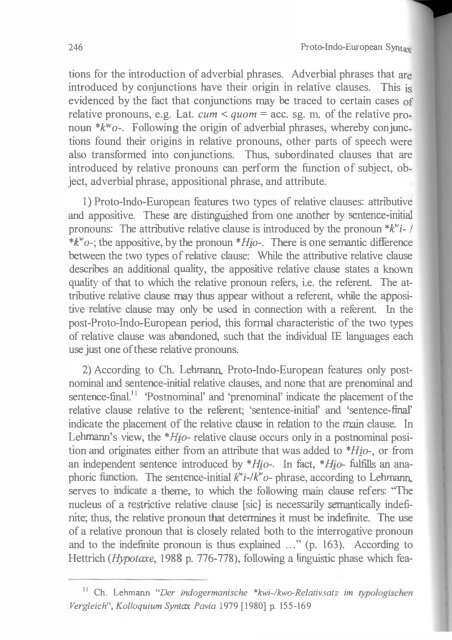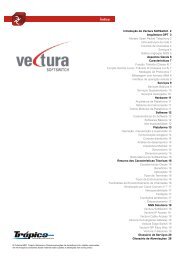Create successful ePaper yourself
Turn your PDF publications into a flip-book with our unique Google optimized e-Paper software.
246 Proto-lndo-European Syntaxlions for the introduction <strong>of</strong> adverbial phrases. Adverbial phrases tbat areintroduced by counctions bave their origin in relative clauses. This isevid 7nced by the fact that conjunctions may be traced to certain cases <strong>of</strong>relatIve pronouns, e.g. Lat. cum < quom = acc. sg. ill <strong>of</strong> the relative pronoun'kwo_. Following the origin <strong>of</strong> adverbial phrases, whereby conjunc_lions found their origins in relative pronouns, other parts <strong>of</strong> speech werealso transformed into conjunctions. Thus, subordinated clauses that areintroduced ?y relative pronouns can perform the function <strong>of</strong> subject, obJect, adverbIal phrase, appositional phrase, and attribute.I) Proto-Indo-European features two types <strong>of</strong> relative clauses: attributiveand appositive. These are distinguished from one another by sentence-initialpronouns: The attnbutive relative clause is introduced by the pronoun *k"'i- /'k'" 0-; \be appositive, by the pronoun ' Hjo-. There is one semantic differencebetween the two types <strong>of</strong> relative clause: While the attributive relative clausedescribes an additional quality, \be appositive relative clause states a knownquality <strong>of</strong> tbat to which the relative pronoun refers, i.e. the referent. The attributiveelative clause may thus appear without a referent, while \be apposit,verelallve clause may only be used in connection with a referent.In thepost-Proto-Indo-European period, this fonnal characteristic <strong>of</strong> the two types<strong>of</strong> relallve clause was abandoned, such tbat the individual lE languages eachuse just one <strong>of</strong>\bese relative pronouns.2) According to Ch. Lehmann, Proto-Indo-European features only postnominaland sentence-initial relative clauses, and none that are prenominaJ andsentence-final." 'PostnominaJ' and 'prenominaJ' indicate the placement <strong>of</strong> therelative clause relative to \be referent; 'sentence-initial' and 'sentence-finaJ'indicate the placement <strong>of</strong> the relative clause in relation to the main clause. InLehrnann's .view, \be .'Hjo- relative clause occurs only in a postnominaJ posilionand ongmates eIther from an attribute that was added to 'Hio- or froman independent sentence introduced by 'Hio-. In fuet, • Hjo- an anaphoricfuntion. The sentence-initial k"'i-/k'" 0- phrase, according to Lehmann,serves to indIcate a \berne, to which \be fo llowing main clause refers: ''Thenucleus <strong>of</strong> a restri c:tive relative clause [sic] is necessarily semantically indefirute;thus, \be relallve pronoun that detennines it must be indefinite. The use<strong>of</strong> a relative pronoun tbat is closely related both to the interrogative pronounand t ?the indefinite pronoun is thus explained . .. " (p. 163).According toHettrich (Hypotaxe, 1988 p. 776-778), fo llOwing a linguistic phase which fea-sentence Syntax 247relative participles, relative clauses develop fro paratactically coorditU:clauses with anaphoric. pronouns, process which leads m turn to thena . n <strong>of</strong> appositive-explicallve relallve sentences (from sentences WIth:aJ anaphoric 'kwi_/'k'" 0-). For ịnformation n morplogy, c .f F 404.furrn;:::c 'Hjo-) and attributive-restrictive relative clauses (from sentences.. . . .FM m ore information regardmg the termmology apposlllve vs. attnbu-t ·d· Ch,. Seiler Relativsatz 1960; concerrung apposItIve vs. restnctlve: LehmanO Relativsatz 1984 and Hettrich Hypotaxe 1988. Accor mg toK It, there was no relative attribute in Proto-Indo-European, but rather Itoc· f · 1 1 ·developed in individual lE languages upon the baSIS 0 nomma re aliveclauses.123. Verbal and Nominal PhrasesS 206. In a verbal phrase, the finite verb determines the actants, whichare governed by rules <strong>of</strong> dependence. In the nominal phrase, there IS n<strong>of</strong>inite verb to determine the actants. Nominal phrases are not simply verbalphrases without a finite verb (with what is called elipsis <strong>of</strong> the copula), butrather constitute an independent type <strong>of</strong> clause. Thus, the predIcate nounin nominal phrases is always stressed, unlike the verbal predicate in verbalphrases. In fact the term 'elipsis' is not exact, since the copula is not essential.Contrarily, the use <strong>of</strong> the copula should rather be seen as an adaptationto the common pattern <strong>of</strong> verbal phrases, which always feature afinite verb form. This use <strong>of</strong> the copula is in fact a sort <strong>of</strong> explicative signification,in which the content <strong>of</strong> the copula is expressed through theconnection <strong>of</strong> the various sentence elements and is given particular emphasisalone through an independent linguistic symbol <strong>of</strong> comparable meaning.S 207. For more information on parataxis: -7 Kieckers Steflung desVerbs 191 1; Ammann Untersuchungen I 1922; by the same author, "Untersuchungenzur homerischen Wortfolge und Satzstruktur. 2. Te il: DieSteflung des Verbums, im Einzelnen untersucht" in IF 42 1924 p. 149-171and 300-322; W. Dressier "Eine textsyntaktische Regel der idg. Wortstellung"in ZVS 83 1969 p. 1-25; R. Harweg "Zum Verhiiltnis von Satz,Hauptsatz und Nebensatz" in ZDL 38 1971 p. 16-46; C. Watkins "SomeIndo-European verb-phrases and their transformations " in Selected... .I JCh. Lehmann "Der indogermanische ·kwi-Ikwo-Relativ.vatz im typ% gischenVergleich", Kol/oquium Syntax Pavia 1979 [1980J p. 155-16912"Zur Vorgeschichle des relaliven Atlribu/ivkonnexes im Baltischen und Slavischen"in Kolloquium ldg., Slow. u. Bolt. Jen. 1989 [1992J p. 45-88





